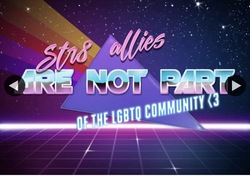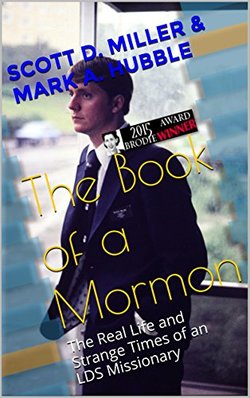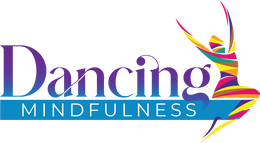 As my good friend Rachel observed, many of us seem to be emotionally sunburnt with the triggers of the 2016 Presidential Election bombarding us on a daily basis. I, for one, admit that I am more than sunburnt… I am crispy. Normally I would take a few days to make sure that I am responding from a place of love instead of reactivity before I endeavor on a post of this nature. There is a story that I have to share that I've not yet shared in this way. It is National Coming Out day so today seems as good a time as any. I am pissed and, quite frankly, emotionally charged by a meme that I saw floating through social media yesterday declaring: “Straight Allies Are Not a Part of the LGBTQ Community.” What I share in this blog is concern, born out of my lived experience, on why such a message promotes some of the very same hatred that many of us are trying to challenge in society at large. There are numerous permutations of the LGBT+ abbreviation. Opinion is clearly split, depending on who you ask, about whether the “A” in one version of the abbreviation, LGBTQQIA, stands for asexual or allies. A variety of other sources use an even longer abbreviation LGBTQQIAA to recognize both asexual individuals and allies. Even with this longer abbreviation, concerns are still raised that pansexual, polyamorous, and individuals who identify in a variety of ways that have made them feel excluded, different, or misunderstood are not officially included in our letter soup. Yet this conversation around inclusion in an abbreviation has greater implications than simple semantics. What do we define as inclusion and what does it mean when we say that allies are not part of our “community”? Because any organization connected to LGBT+ rights I’ve ever been involved with includes “ally” or “allies” in their marketing, this meme surprised me. I am a bisexual woman whose coming out was a very graduated process. I knew at the age of 11 that I was romantically attracted to both males and females (at that time my thinking around gender was largely binary, informed by my upbringing). The first time I even considered coming out about my attractions bisexual identity was at the age of 19. Having just left a conservative home (mixed Catholic and Evangelical) and still relying on my home base for financial support, to come out in any capacity equaled death. As my second year of college progressed, I eventually felt safe enough to come out at an ally—and I took a good deal of shit for that in various circles of my life. Although I knew deep down that I really wasn’t “straight,” it seemed safest at the time to let my family and others around me keep thinking that I was. Am I proud of hiding so much of myself for so long? Of course not. Do I still experience some shame when I hear about kids who were willing to lose it all in order to come out? Yes. But this was part of my story. I hear tolerance and compassion from many people I admire in LGBTQQIAA circles that the coming out process ought never be forced. For me, coming out as an ally was a necessary first step in my process. After leaving an Evangelical church I ended up in Catholicism for a few years, desperately seeking some spiritual solution, and remained an ally even as I explored those circles. While working at a major pilgrimage site and mission organization in Eastern Europe, I regularly spoke up when priests and other members of the church were talking smack about queer people. I asked the same types of questions during my graduate education at a very conservative Catholic institution, often being shut down and ostracized. Even if I had only been a straight person (and not a closeted bisexual), the experience taught me just how scary it is for any ally, regardless of how they identify, to speak up in hostile situations. Any ally willing to do this in any capacity, especially if they come from a conservative or religious background, is taking a risk and even if no one else is grateful for them, I am. As an unspecified ally throughout my young adult years, I had the golden opportunity to be embraced by many individuals of diverse sexual and gender orientations. I felt accepted. It felt like their welcome was the anecdote to what I experienced in the church circles with which I found myself involved through the first quarter of my life. Eventually I felt strong enough to start coming out as bi to close friends and romantic partners. Then I started coming out to professionals in my circles I identified as safe. From there I built the strength to come out to my family and close conservative friends and eventually I freed myself to not be embarrassed, in any circle, to declare who and what I am. If I had seen this meme or encountered this kind of exclusionary thinking during my long journey of discovery, I would have felt just as shut down as did all of those years sitting in church circles. I would have been met with a sense of, “I guess I’m not safe here too,” or I would have been forced to come out before I was ready just to fit in. In reading comments and hearing others experiences’ about how annoying allies can be, I want to assure you that I do acknowledge your perspective. There are allies out there who will talk a good game about being an “ally” because it’s cool or the right thing to do as a liberal thinker and will not actually lift a finger to change things for the LGBTQQIAA community. I also acknowledge that some of us only feel safe and secure around people who identify just like us. Having too many allies around, especially those who are allies in name only, may threaten our perception of safety. Speaking purely for myself and no one else, I will never feel safe in any community where there is any policy of exclusion, either implicit or explicit. Messages like “you don’t belong here,” “you’re not one of us,” or “you’re not part of the family, the tribe, etc.” can be very damaging and I had my fill of them years ago in conservative circles. As individuals who do not identify as straight, we must do better than this. It’s funny—as I am about to click “publish” I can already hear the comments being thrown at me about my various levels of privilege, especially my passing privilege as a bisexual. I acknowledge those fully and still believe that all of us, regardless of our letter in the letter soup of identifiers, hold a piece of the truth. We all have something to share and to contribute. And this includes straight allies. Perhaps for me, as I breath and attempt to integrate my visceral reaction from yesterday, the solution is to not see the LGBTQQIAA umbrella as one community; a binary construct that I either fit into or don’t. Rather, the challenge for me and for many of us may be to find the pockets of safety, the smaller communities within the larger community, where we do experience safety, belonging, and a place to be our authentic selves. I have found mine—and it’s my sincerest wish to anyone reading this that you find yours as well.
1 Comment
 A few months ago, I learned that Dr. Scott Miller (one of my favorite clinical writers and thinkers) wrote a memoir about his 2-year experience on a Mormon mission. In the next breath, I jumped on Amazon to order my copy. I initially encountered Scott Miller and his associates’ work in 2009. Around this time, my frustrations with the dogmatic nature of the leadership surrounding my primary therapeutic modality of practice, EMDR therapy, mounted to the point that I almost abandoned it as an intervention. Then, I heard Dr. Scott Miller speak at a conference and I found his whole view of our psychotherapeutic professions to be refreshing. His willingness, like Dr. Saul Roszenweig before him, to make comparisons between religious devotion to a certain faith denomination and zealous devotion to a school of psychotherapy impressed me. Almost immediately into reading The Book of a Mormon, my understanding for why I admire Scott Miller so much deepened. I was impressed, in the first pages, at the way his tone did not come across as anti-faith. Indeed, in speaking of those who engage in practices like going on missions as an expression of faith (or doing what they believe to be the right thing), Miller writes, “No one who goes through such an experience merits scorn or ridicule, much less disinterest. They deserve our empathy. This is what I hope to achieve by revealing the real life and strange times of my own mission experience.” As someone who worked for a pretty conservative parish within the Catholic church for 2 ½ years following my undergraduate education, I was asked to do things I didn’t really believe at my core. However, the church had me believing that their way was the right way. As a girl who wanted so desperately to do the right thing, I followed suit. I felt Miller’s extension of empathy envelope me; I can still struggle with feelings of shame and regret around actions I performed in the name of God/the church while working on my own version of a mission. Miller’s tales that compose the book are whimsical, insightful, and dripping with humanity. The cast of characters that he introduces (particularly the rigid mission area president) and his series of mission companions that he served with during his two years in Sweden, particularly animate these stories. His interactions with locals within the Sweden-Goteborg mission area were especially well told and full of spirit. These individuals struck me as his real teachers during his two-year mission. I was particularly moved by Miller’s account of meeting a non-Mormon Swedish woman, the first person he ever met to have a sambo (living companion). Miller’s reflection upon how she seemed to be a happy, well-adjusted person without any kind of faith and while living in a manner that flew in the face of everything he’d been raised with as a Mormon was particularly moving. Another highlight of his memoir was witnessing how he connected the dots about the way that the Mormon script for evangelizing completely contradicted Swedish cultural norms. Miller’s challenges to these aptly observed contradictions were swiftly shut down. Not only did I relate to many of these tales, I found them to be the pivotal observations that would go on to inform my career as a helping professional. I found myself wondering if Miller views his own challenging of the rules in a similar way. In the end, Miller survived his two-year mission and emerged from the experience with a strong competency in the Swedish language (enough to earn a minor in it from Brigham Young University, where he completed undergrad) and a refreshed perspective on how the world works. It was a perspective that seemed to grow from many early days of wondering if he could get through this experience, to being able to mentor others on mission with him, particularly with language skills, and to become able to practice empathy where so many others could not. Miller reflects, “The experience irrevocably changed me. Everything I grew up believing about what most matters in life—family, faith, friendship—was turned upside down. Actually, it was ripped away. I was no longer innocent.” I am grateful that Dr. Miller chose to put himself out there in this fashion and share about this time in his life in such an honest, candid way. As he noted, his tale is not one of scandal and salaciousness that we sometimes crave when we pick up church memoirs of this nature. His tale is of a young Mormon kid whose world was rocked by serving in this capacity. Indeed, reading the stories that comprised this rocking and its resulting awakening can be a learning experience for others who are in some way finding their entire worldview challenged. I believe that many more of us who work in psychology or the helping professions have stories like this to share—of losing faith and finding it all over again when we start to challenge what we’ve been told to believe… of learning to have faith in ourselves and what we are observing about how the world works. |
Dr. Jamie MarichCurator of the Dancing Mindfulness expressive arts blog: a celebration of mindfully-inspired, multi-modal creativity Archives
September 2022
Categories
All
|
Contact |
Memberships & Affiliations |
|
Please direct all inquiries to:
[email protected] © Mindful Ohio & The Institute for Creative Mindfulness, 2021 Terms of Use Privacy Policy |
Dancing Mindfulness/The Institute for Creative Mindfulness is an organizational member of the International Association of Expressive Arts Therapists, the Dance First Association, and NALGAP: The Association of Gay, Lesbian, Bisexual, Transgender, Addiction Professionals and Their Allies; Dancing Mindfulness proudly partners with The Breathe Network and Y12SR: The Yoga of 12-Step Recovery in our shared missions.
|

 RSS Feed
RSS Feed